#ammonite cephalopod fossil
Explore tagged Tumblr posts
Photo

HYPOPHYLLOCERAS ononense Fossil Ammonite, Hauterivian Stage, Cretaceous Madagascar | Authentic Specimen + COA
HYPOPHYLLOCERAS ononense Fossil Ammonite – Hauterivian Stage, Early Cretaceous Period, Madagascar
A rare and elegant fossil ammonite from the Early Cretaceous seas of Madagascar, this specimen of Hypophylloceras ononense is a stunning example of an extinct cephalopod that lived during the Hauterivian stage, around 132 to 129 million years ago. This piece offers exceptional preservation and intricate morphology, ideal for collectors and educational display.
Fossil Type & Species:
Type: Invertebrate Fossil (Ammonite Shell)
Species: Hypophylloceras ononense
Order: Ammonitida
Suborder: Phylloceratina
Family: Phylloceratidae
Described by: Yamani, 1954
Geological & Stratigraphic Details:
Formation: Likely from marine limestone beds of the Mahajanga Basin, Madagascar
Geological Stage: Hauterivian (Early Cretaceous)
Age: Approx. 132–129 million years ago
Depositional Environment: Marine shelf environment with fine calcareous sediments, ideal for the preservation of cephalopod shells
Biozone: Not formally assigned; part of a known ammonite-bearing horizon in Madagascar’s Cretaceous sequence
Morphology & Features: This specimen of Hypophylloceras ononense showcases beautiful features:
Highly involute shell with tightly coiled whorls and smooth flanks
Globular to compressed shell geometry with minimal ornamentation
Complex suture lines with elaborate lobes and saddles typical of phylloceratids
Preserved in brown to caramel fossil tones, sometimes with calcite infilling or polishing for aesthetic display
Notable: Hypophylloceras represents a lineage of ammonites known for their elegant, smooth shells and complex internal structures. The genus is often considered one of the more primitive members of the ammonite clade during the Cretaceous. Specimens from Madagascar are especially prized for their preservation and display quality.
Specimen Details:
Origin: Madagascar (likely Mahajanga Basin)
Species: Hypophylloceras ononense
Fossil Type: Ammonite Shell (Invertebrate)
Geological Stage: Hauterivian, Early Cretaceous
Size Reference: Scale rule square = 1cm (see photo for full sizing)
Note: The fossil in the photo is the exact specimen you will receive
Authenticity & Quality: All our fossils are 100% authentic and carefully hand-selected. This specimen is accompanied by a Certificate of Authenticity and has not been artificially enhanced or reconstructed.
Why Choose This Fossil? This is a premium-quality ammonite ideal for:
Collectors of rare Cretaceous ammonites
Teaching or educational use in palaeontology
Decorative natural history displays
Unique gifts for fossil lovers or science enthusiasts
Shipping & Packaging: Your fossil will be securely packaged with environmentally conscious materials. We offer fast, reliable shipping and expert handling to ensure safe delivery.
Add a remarkable relic of ancient ocean life to your collection with this beautiful Hypophylloceras ononense ammonite fossil from Madagascar.
All of our Fossils are 100% Genuine Specimens & come with a Certificate of Authenticity.
#Hypophylloceras ononense fossil#Hauterivian ammonite#Cretaceous ammonite fossil#Madagascar ammonite#genuine ammonite fossil#real ammonite shell#fossil with COA#rare ammonite species#Hypophylloceras fossil Madagascar#ancient marine fossil#collector ammonite specimen#polished ammonite Madagascar#ammonite fossil for sale#ammonite cephalopod fossil#early Cretaceous ammonite
0 notes
Text
Ammonites were some of the most diverse organisms in the ancient ocean. The Museum holds one of the world’s largest collections of ammonites, containing nearly two million specimens that represent 300 million years of Earth’s history!
#science#amnh#museum#fossil#nature#natural history#animals#paleontology#fact of the day#ammonite#prehistoric#cephalopod#squid#fossils#museums#natural history museum#ancient animals#cool animals#ocean life#extinct animals#did you know
1K notes
·
View notes
Text

Work in progress on a goniatite painting. What other critters should I add?
#geology#geologyjohnson#palaeontology#fossils#fossilfriday#fossil#paleontology#ammonite#ammonoid#Goniatite#cephalopods#cephalopod
190 notes
·
View notes
Text

An ammonite fossil of a Sigaloceras enodatum from the Kellaways Formation in Station Quarry, South Cave, Near Hull, Yorkshire, England. This Middle Jurassic aged ammonite is preserved in calcite and is from an old English collection from a locale that is now a nature reserve.
#ammonite#cephalopod#fossils#paleontology#palaeontology#paleo#palaeo#sigaloceras#kosmoceratidae#jurassic#mesozoic#prehistoric#science#paleoblr#シガロセラス#コスモセラス科#アンモナイト#化石#古生物学
63 notes
·
View notes
Text
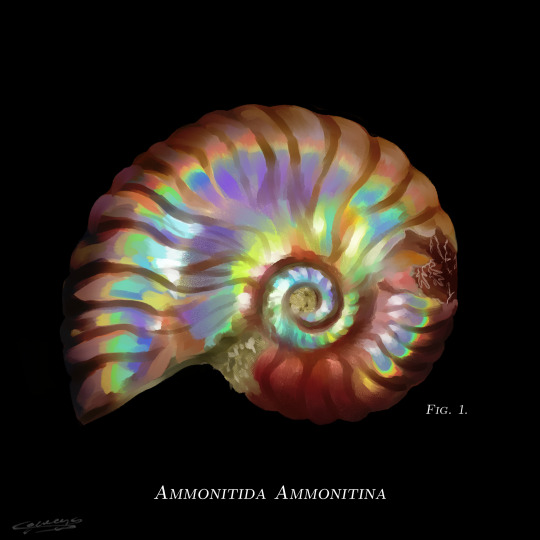
opalescent ammonite fossil
reference
#paleoart#ammonite#paleontology#art#artists on tumblr#painting#my-art#cephalopods#fossils#marine life#x
101 notes
·
View notes
Text
Sunday Scribbles: How to Draw and Ammonite
Ever wanted to draw an ammonite but didn't know how? Well, you're in luck! Here's a simple guide to help you draw the perfect ammonite.
STEP 1: Draw a cinnamon roll

STEP 2: Draw a cresent moon for the aperature (remember from yesterday's lesson that's the shell opening).

STEP 3: Draw a little circle in front of the aperature.

STEP 4: Draw a Dorito above the circle. (Prove how hungry you are because it's fast Sunday.)

STEP 5: Channel Davy Jones onto the page by drawing tentacles coming out of the aperarure below the Dorito.

STEP 6: Draw squiggly lines on the shell for the sutures.

An voila! You have an ammonite!

31 notes
·
View notes
Text
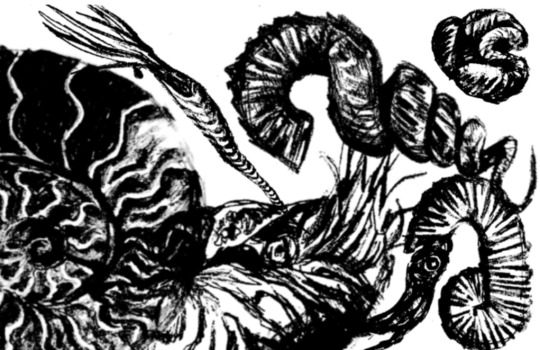
whatever. go my ammonites
#dear whomever points out the fact that there's a tiger nautilus in there. i'm a fraud i know. can i kiss you please.#aquatic#ocean#ammonite#cephalopod#fossils#prehistoric#meat tasting sky#wolframmidnights#fish
3 notes
·
View notes
Photo

Liparoceras cheltiense Ammonite Fossil - Pliensbachian, Jurassic, Cheltenham, United Kingdom | 100% Genuine Specimen + COA
A stunning and rare Liparoceras cheltiense Ammonite Fossil, from the Pliensbachian Stage, Jurassic, discovered in Cheltenham, United Kingdom. This beautifully preserved ammonite showcases intricate ribbing and involute coiling, offering an exceptional piece of prehistoric marine history. A highly sought-after specimen for collectors, educators, and fossil enthusiasts alike.
✅ 100% Genuine Specimen – Every fossil we sell is authentic and comes with a Certificate of Authenticity.
✅ From the Alice Purnell Collection – A carefully curated specimen with historical significance.
✅ What you see is what you get – The listing photos show the exact fossil you will receive.
✅ Includes size reference – Scale cube in photos = 1cm. Please refer to the images for full dimensions.
✅ Ideal for collectors, display, or scientific study – A visually striking and scientifically significant fossil specimen.
About Liparoceras cheltiense Ammonite Fossils:
Liparoceras cheltiense is an extinct species of ammonite that thrived during the Early Jurassic period, approximately 190 million years ago. Ammonites were marine mollusks related to modern-day squids, octopuses, and nautiluses, playing a crucial role in prehistoric ocean ecosystems before their extinction.
This fossil originates from the Pliensbachian Stage, specifically from Cheltenham, UK, an area known for its remarkable ammonite preservation. Liparoceras is recognized for its robust shell, prominent ribbing, and deep suture patterns, making it a valuable specimen for both collectors and researchers.
Fossils like Liparoceras cheltiense provide valuable insight into ancient marine environments, ammonite diversity, and evolutionary adaptations. Their distinctive beauty and historical significance make them a perfect addition to any fossil collection.
Perfect for display, educational purposes, or as a unique gift for fossil lovers and paleontology enthusiasts, this ammonite fossil is a one-of-a-kind specimen.
Shipping & Packaging:
🔹 Securely packed for safe transit 🔹 Worldwide shipping available 🔹 Tracked & insured delivery options
Why Buy from Us?
🔹 Trusted Seller – Specializing in fossils, minerals, and natural history specimens. 🔹 Certified Authenticity – Every purchase includes a signed Certificate of Authenticity. 🔹 Ethically Sourced – All our fossils are legally and responsibly collected.
Own a scientifically valuable piece of Jurassic ammonite history today!
#Liparoceras cheltiense#ammonite fossil#Jurassic ammonite#Pliensbachian ammonite#Cheltenham fossil#UK fossil#prehistoric marine fossil#ammonite collector#rare ammonite#fossilized ammonite#geological specimen#fossil display#ammonite identification#ammonite paleontology#fossil hunting#ammonite evolution#Alice Purnell Collection#cephalopod fossil#fossil enthusiast#ammonite shop#ammonite decor#ammonite history#fossil gift#natural history#fossilized ammonite block#ancient ammonite remains
2 notes
·
View notes
Text
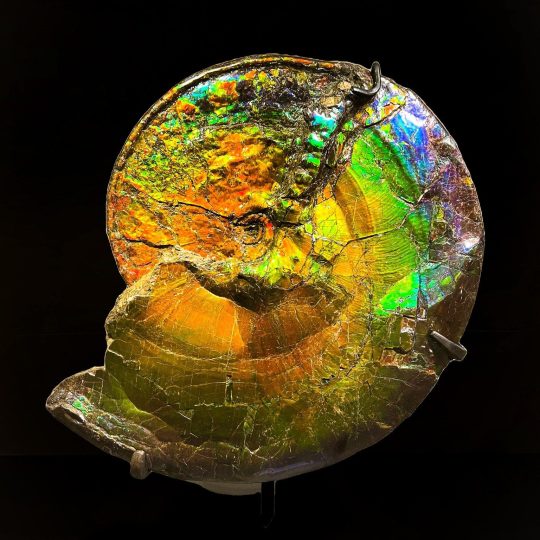
Behold the dazzling colors of an iridescent ammonite (Placenticeras intercalare)! A relative of today’s squids, this ammonite lived some 80 million years ago near what is now Alberta, Canada. This fossil’s spectacular coloration is the result of millions of years of high temperatures and pressures. As these forces acted on nacre in this ammonite’s shell, it was transformed into a gemstone known as an ammolite. Along with amber and pearl, ammolite is one of only a handful of gems made by living organisms. You can spot this rare specimen in the Louis V. Gerstner, Jr. Collections Core in the Museum’s Richard Gilder Center for Science, Education, and Innovation!
Photo: © AMNH
#amnh#museum#science#nature#fossil#natural history#animals#paleontology#ammonite#ammolite#did you know#fact of the day#rainbow#cool animals#alberta#pride#iridescent#cephalopods#squid#ancient animals
1K notes
·
View notes
Text
Ammonites are an extinct subclass of cephalopods that lived from the Devonian period to until the Cretaceous-Paleogene extinction event. They had external shells in a variety of different shapes, from Nautilus-like planispirals, to long cone like heteromorphic shells.

A cool example of an ammonite shell

Doodlin
#cephalopod#cephalopods#marine biology#biology facts#ammonite#marine life#fossils#Ammonites are one of my fav types of cephalopods#I love them so much
989 notes
·
View notes
Text

An ammonite fossil of a Prolyelliceras prorsocurvatum from the Machay Group in Oroya, Peru. Prolyelliceras peruvianum is likely synonymous with this Cretaceous species.
#ammonite#cephalopod#fossils#paleontology#palaeontology#paleo#palaeo#prolyelliceras#prolyelliceratidae#cretaceous#mesozoic#prehistoric#science#paleoblr#fossil friday#fossilfriday#プロリエリセラス#プロリエリセラス科#アンモナイト#化石#古生物学
27 notes
·
View notes
Text

1 note
·
View note
Text
i was so hung up on the text misidentifying plesiosaurs and ichthyosaurs as "dinosaurs" that i completely missed how they called ammonites and belemnites "stones".

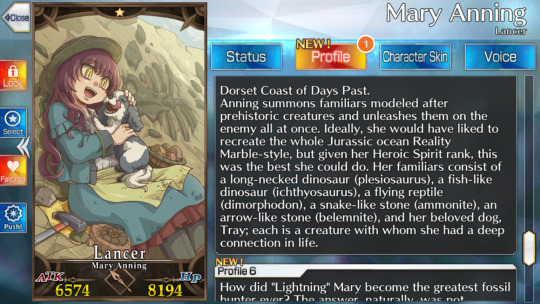
come on man, how do you correctly identify the pterosaur as a flying reptile distinct from dinosaurs, but in the same sentence call plesiosaurus and ichthyosaurus 'dinosaurs'
#I MEAN I GUESS THEY'RE STONES NOW#but if you're gonna be that technical so's everything else she summons asdgfhdjdshadshf#for the record ammonites and belemnites *were* cephalopods - close relatives to octopus and squid#but ammonites are famous for having an external shell (which could get really really weird in some species)#and both groups of animals are very very commonly found as fossils#hakunonon vs the gacha
9 notes
·
View notes
Text
Science Saturday: Ammonite Anatomy
Wow! Thanks for all the reblogs friends! it makes me feel all warm and bubbly inside.

Who's ready to learn a little anatomy this fine Saturday?

Good! Now, ammonites are arguably the most abundant fossil found today. They are incredibly popular due to this abundance and the different types of shells abound.
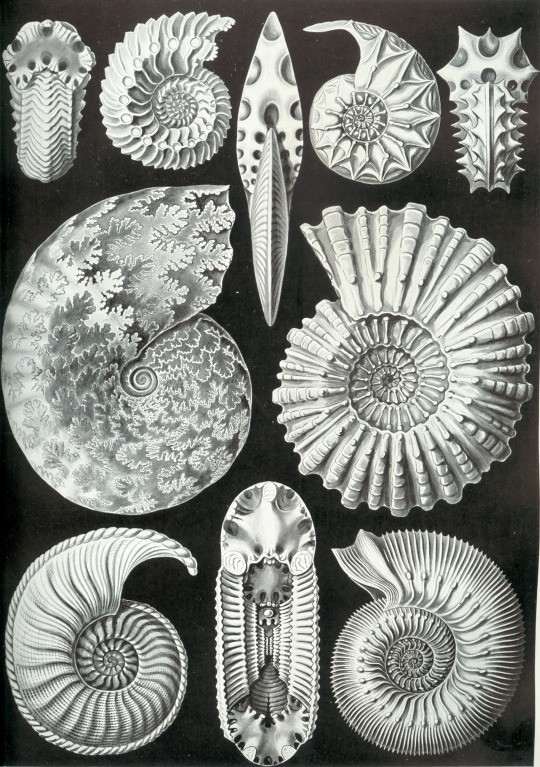
While they may look physically different, they anatomy is the same (otherwise it would be a different animal, right?). Let's take a look at some basic shell anatomy:
Camerae

No, camerae not cabaret. Sheesh. Camerae (camera in the singular) are the chambers separated by walls called septa (septum in the singular) that strengthen the shell against external water pressure. Filled with air and sometimes water.
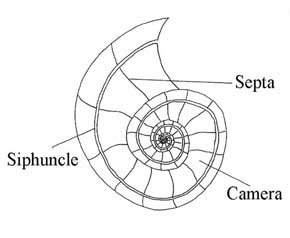
Also pictured here is the siphuncle. This is a tube that connects the camerae and pumps fluid in and out to adjust buoyancy. Think of it like a fancy straw.
Next we have the sutures. These are the lines where the septa join the shell wall. They make up all the fancy patterns on the outside of the shell.


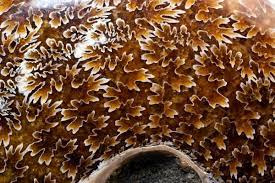
Next, we have the aperature. This is simply the shell opening. Found next to the body chamber or body camera. This is the chamber the animal actually lived in.

No. Just no.
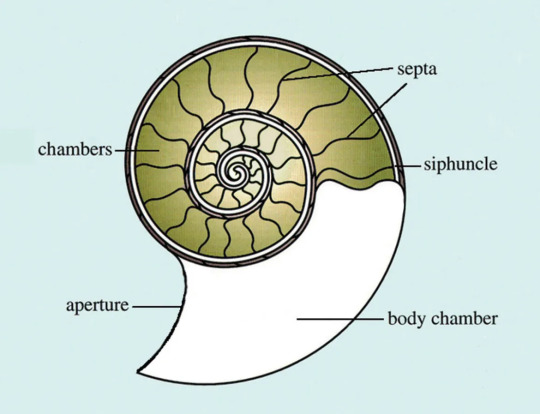
There we go. So, there you have it! All the basic shell anatomy in one place! Aren't they cool little suckers?

22 notes
·
View notes
Text

Ammonites muticus. Art-studies from nature. 1872. Cephalopod fossil.
Internet Archive
#ammonites#spirals#spiral#paleobiology#paleontology#fossils#art forms in nature#nemfrog#1872#19th century#spiky#punk
639 notes
·
View notes
Text
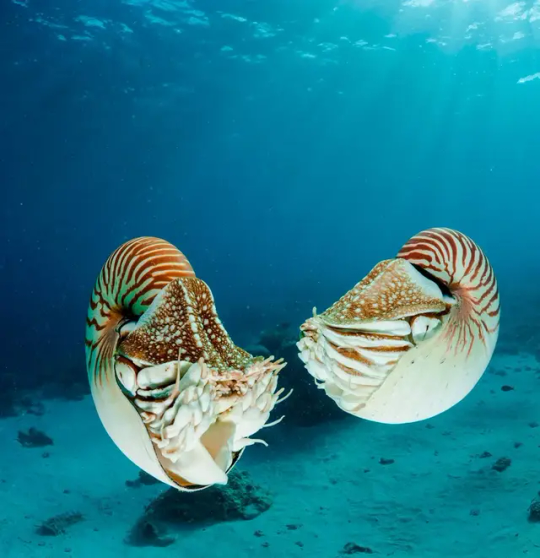

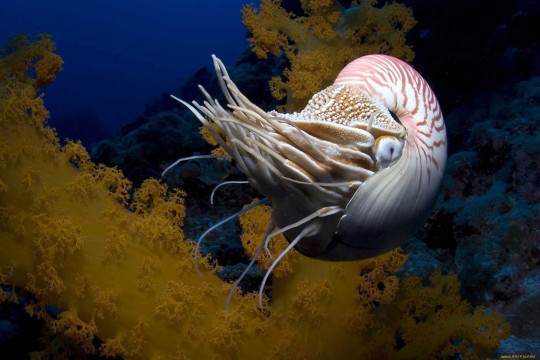
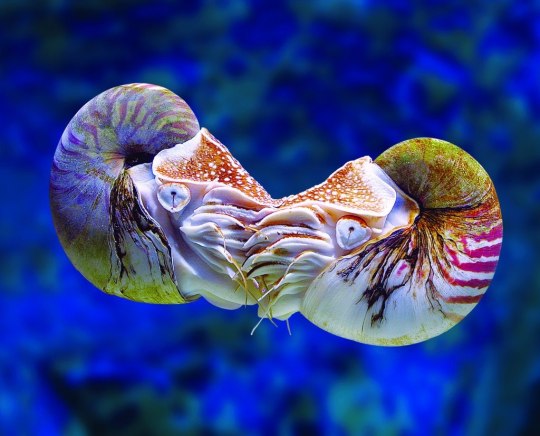
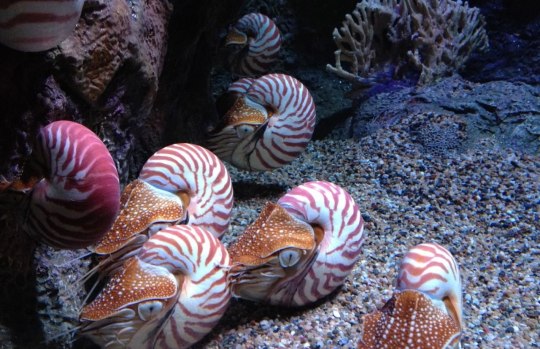
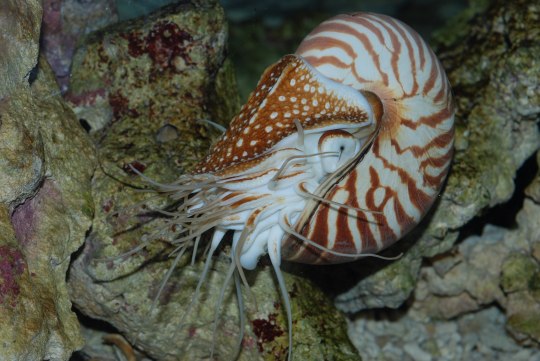
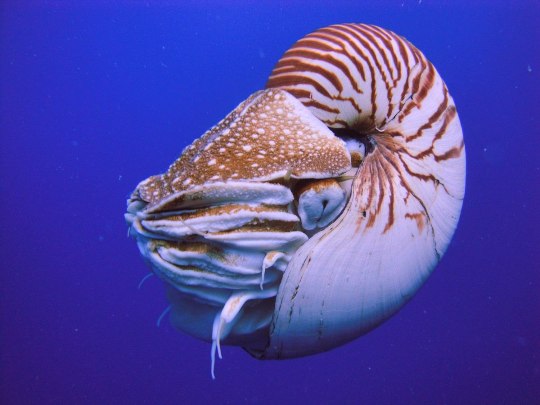
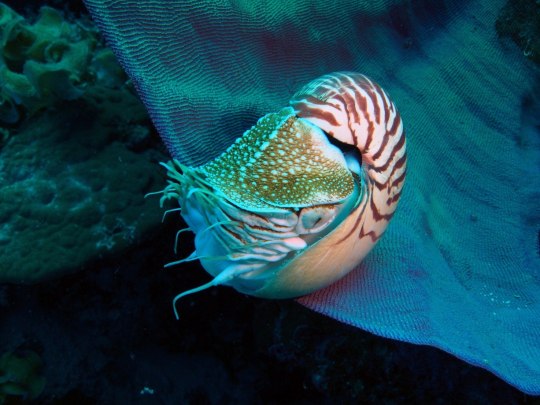




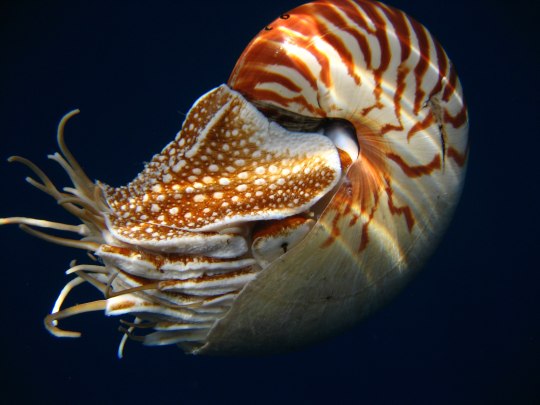
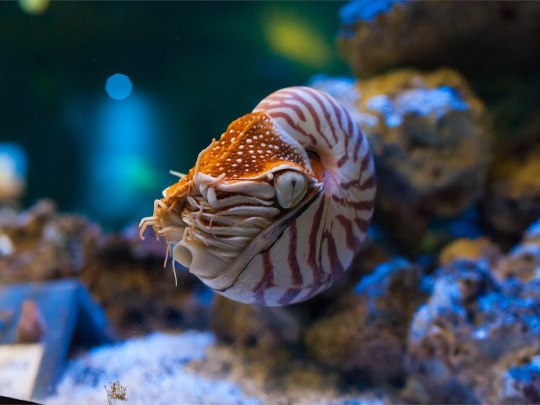
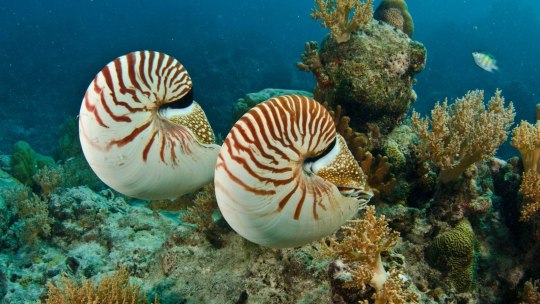
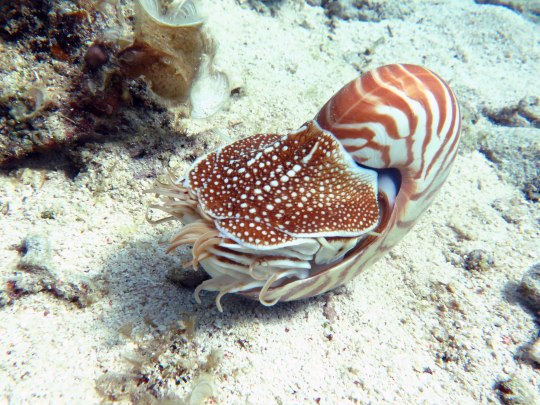
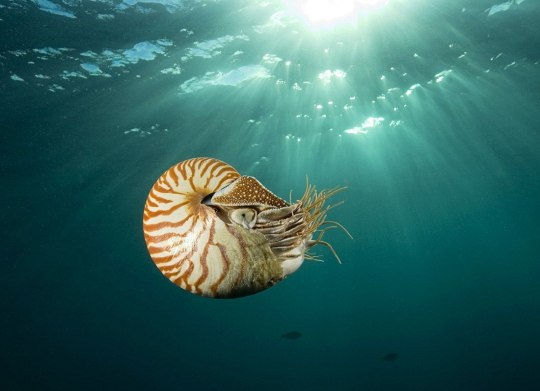

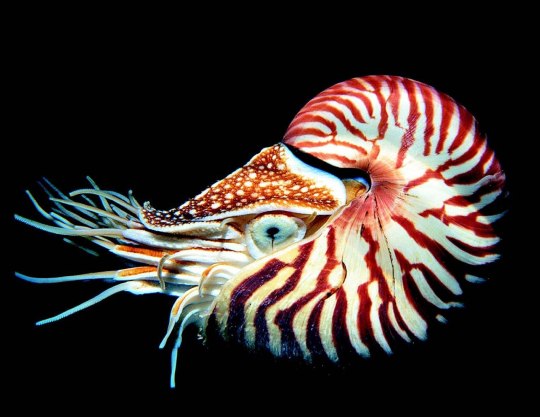

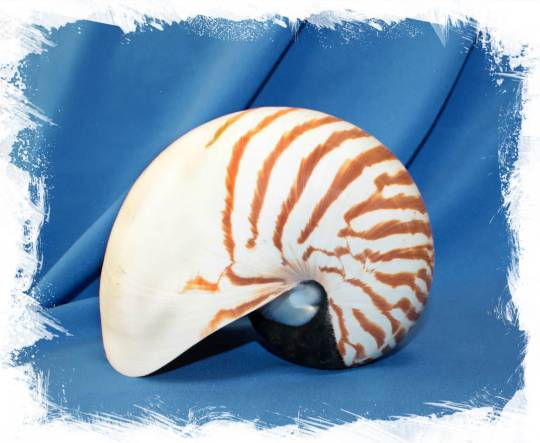
Наутилус (лат. Nautilus) — род головоногих моллюсков, которых относят к «живым ископаемым». Самый распространенный вид — Nautilus pompilius. Наутилусы относятся к единственному современному роду подкласса наутилоидей. Первые представители наутилоидей появились в кембрии, а его развитие пришлось на палеозой. Наутилиды почти вымерли на границе триаса и юры, но все же дожили до наших дней, в отличие от своих родственников аммонитов. Некоторые виды древних наутилусов достигали размера в 3,5 м. Представители самого крупного вида современных наутилусов достигают максимального размера в 25 см.
Спиральный «домик» моллюска состоит из 38 камер и «построен» по сложному математическому принципу (закон логарифмической прогрессии). Все камеры, кроме последней и самой большой, где размещается тело наутилуса с девятью десятками «ног», соединяются через отверстия между собой сифоном. Раковина наутилуса двухслойная: верхний (наружный) слой – фарфоровидный – действительно напоминает хрупкий фарфор, а внутренний, с перламутровым блеском – перламутровый. «Домик» наутилуса растет вместе с хозяином, который перемещается по мере роста раковины в камеру попросторней. Пустое жилище моллюска после его гибели можно встретить далеко от его места обитания – после гибели «хозяина» их раковины остаются на плаву и перемещаются по воле волн, ветров и течений.
Интересно, что двигается наутилус «в слепую», задом наперед, не видя и не представляя препятствий, которые могут оказаться на его пути.И еще одно удивительное качество этих древних обитателей Земли – у них потрясающая регенерация: буквально через несколько часов раны на их телах затягиваются, а в случае потери щупальца быстро отрастает новое.
Nautilus is a genus of cephalopods, which are classified as "living fossils". The most common species is Nautilus pompilius. Nautilus belong to the only modern genus of the Nautiloid subclass. The first representatives of the Nautiloids appeared in the Cambrian, and its development took place during the Paleozoic. The Nautilids almost died out on the border of the Triassic and Jurassic, but still survived to the present day, unlike their Ammonite relatives. Some species of ancient Nautilus reached a size of 3.5 m. Representatives of the largest species of modern nautilus reach a maximum size of 25 cm.
The spiral "house" of the mollusk consists of 38 chambers and is "built" according to a complex mathematical principle (the law of logarithmic progression). All chambers, except the last and largest, where the nautilus body with nine dozen "legs" is located, are connected through holes with a siphon. The nautilus shell is two–layered: the upper (outer) layer – porcelain–like - really resembles fragile porcelain, and the inner, with a mother-of-pearl luster - mother-of-pearl. The nautilus's "house" grows with its owner, who moves as the shell grows into a larger chamber. The empty dwelling of a mollusk after its death can be found far from its habitat – after the death of the "owner", their shells remain afloat and move at the will of waves, winds and currents.
Interestingly, the Nautilus moves "blindly", backwards, without seeing or imagining the obstacles that may be in its path.And another amazing quality of these ancient inhabitants of the Earth is that they have amazing regeneration: in just a few hours, the wounds on their bodies heal, and in case of loss of tentacles, a new one grows quickly.
Источник:://t.me/+t0G9OYaBjn9kNTBi, /sevaquarium.ru/nautilus/, /habr.com/ru/articles/369547/, //wallpapers.com/nautilus, poknok.art/6613-nautilus-molljusk.html, //wildfauna.ru/nautilus-pompilius, /www.artfile.ru/i.php?i=536090.
#fauna#video#animal video#marine life#marine biology#nature#aquatic animals#cephalopods#Nautilus#nautilus pompilius#living fossils#ocean#benthic#coral#plankton#beautiful#animal photography#nature aesthetic#видео#фауна#природнаякрасота#природа#океан#бентосные#головоногие моллюски#Наутилус#живое ископаемое#коралл#планктон
187 notes
·
View notes